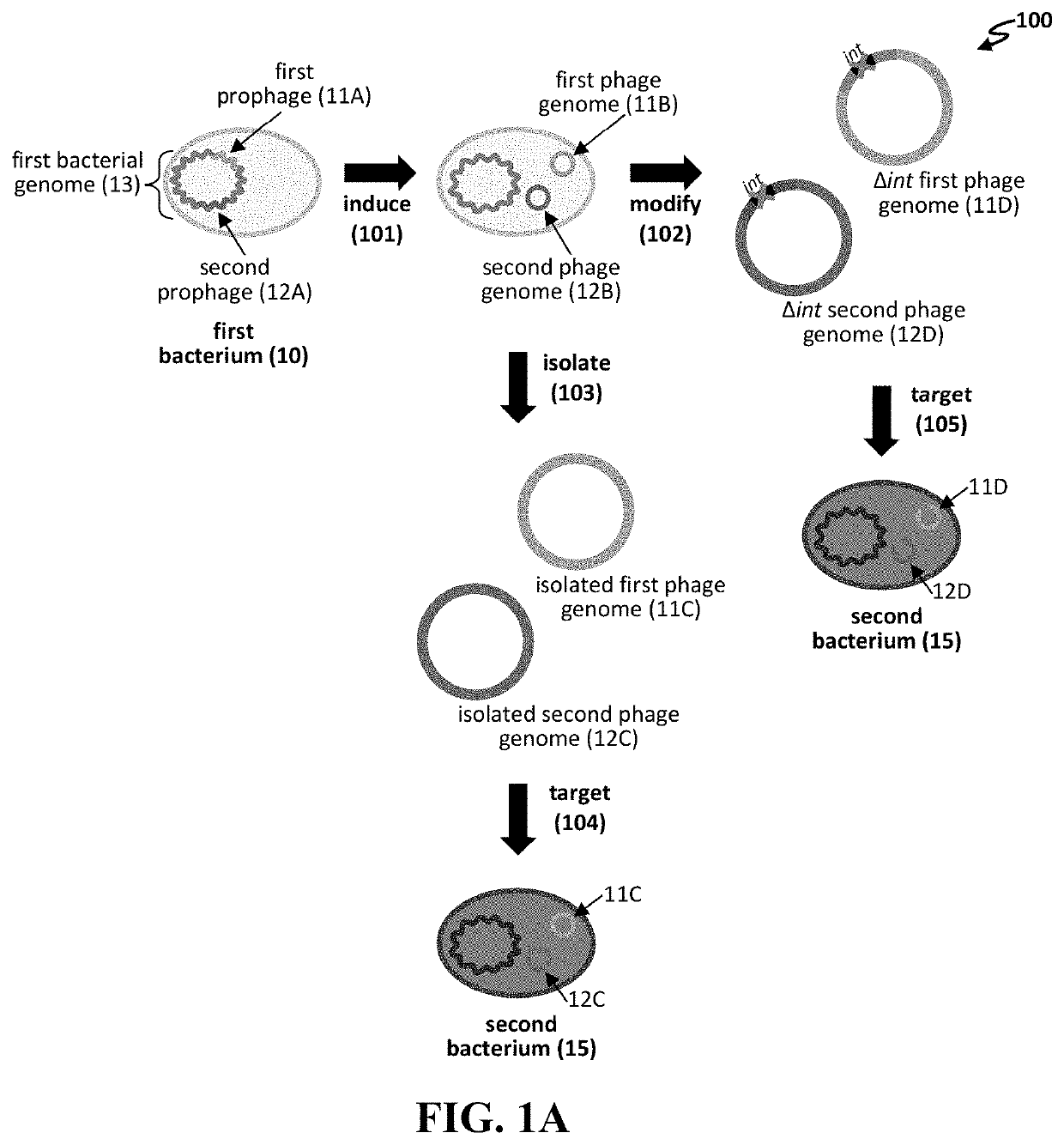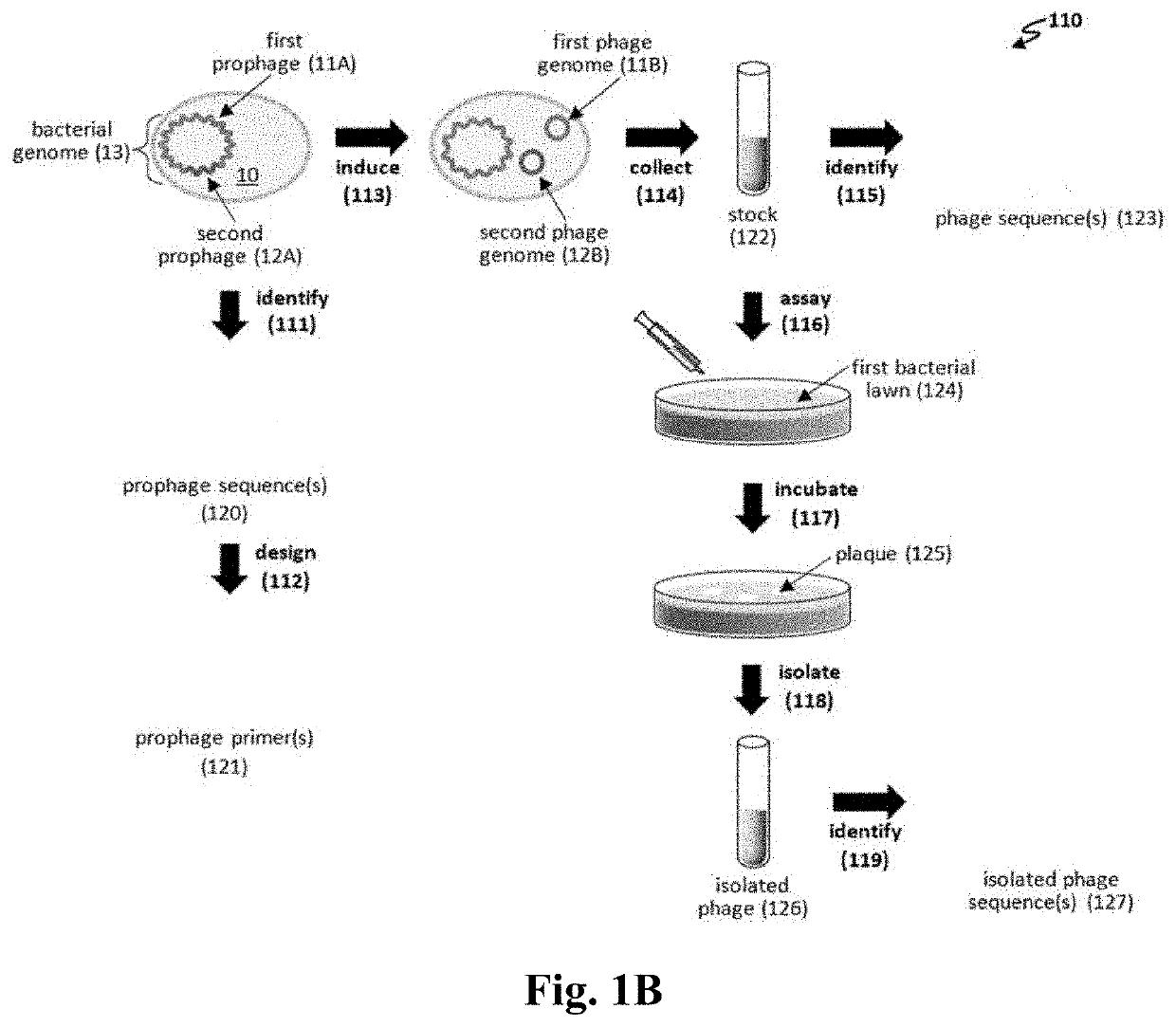Therapeutic phages and methods thereof
- Summary
- Abstract
- Description
- Claims
- Application Information
AI Technical Summary
Benefits of technology
Problems solved by technology
Method used
Image
Examples
example 1
ng and Converting Temperate Phages for Therapy
[0130]Temperate phages grow lytically in most of the bacterial cells they infect, yet produce a small fraction of lysogen cells by repressing lytic growth and establishing stable inheritance, usually through integration into the chromosome. Temperate phages have generally been shunned for therapy because the lysogens i) are not killed, ii) are resistant to reinfection by the original phage, iii) may have gained virulence / resistance / toxin genes enhancing the pathogenicity phenotype (lysogenic conversion), and iv) can occasionally transduce chromosomal markers flanking the integration site (see, e.g., Abedon S T et al., “Phage treatment of human infections,”Bacteriophage 2011; 1:66-85). However, this guideline had set in before the development of a general PCR-based approach for multilocus engineering of bacteriophage genomes (see, e.g., Ando H et al., “Engineering modular viral scaffolds for targeted bacterial population editing,”Cell Sys...
example 2
ed Therapeutic Phage Cocktails from Close Relatives of the Target Bacterium
[0135]Bacteria resistant to multiple antibiotics have become an increasing problem in human health, both in combat medicine and in homeland clinics. Yet there have been no new antibiotic classes discovered since 1987, aside from the yet-unapproved teixobactin (see, e.g., Ling L L et al., “A new antibiotic kills pathogens without detectable resistance,”Nature 2015; 517:455-9).
[0136]The methods herein can enable a leap forward in providing tailored viruses (or bacteriophages or phages) that can infect target pathogens. Phages have been applied therapeutically almost since their discovery in 1915, but their use in Western medicine was eclipsed by the rise of antibiotics (see, e.g., Abedon S T et al., Bacteriophage 2011; 1:66-85). With resistance to antibiotics now building, it is increasingly imperative to redeploy phages. In particular embodiments, phage cocktails can be tailored to effectively leave no survivo...
example 4
d Phages in Liquid Cultures
[0160]We have demonstrated that engineered phages kill P. aeruginosa PAO1 in liquid culture. P. aeruginosa strains used to isolate phages from are Pae5 (ATCC 2192; NCBI: CH482384.1) and Pae1505 (ATCC 27853; NCBI: CP015117.1). As seen in FIG. 9, the following phages killed PAO1 in liquid culture over time: Pae5.41ZΔint, Pae5.42argF WT, Pae5.44GΔint, and Pae1505.52S WT. Whereas WT (wild type) phages can generate resistance through lysogeny, Δint phages generally kill bacteria over time.
Example 5: Phage Therapy in Galleria mellonella
[0161]Waxworms (Galleria mellonella) were injected with Pseudomonas in the right lower pseudopod (FIG. 10A), then 20 minutes later with phage in the left lower pseudopod, and deaths were monitored over 3 days (FIG. 10B). In particular instances, a proportion of worms were saved with single phage injection of Pae5.41ZΔint, Pae5.42 WT, Pae1505.52S WT, Pae1505.52SΔint, or Pae5.64LΔint at MOI of 10. Structural characterization includ...
PUM
| Property | Measurement | Unit |
|---|---|---|
| Fraction | aaaaa | aaaaa |
| Therapeutic | aaaaa | aaaaa |
| Distance | aaaaa | aaaaa |
Abstract
Description
Claims
Application Information
 Login to view more
Login to view more - R&D Engineer
- R&D Manager
- IP Professional
- Industry Leading Data Capabilities
- Powerful AI technology
- Patent DNA Extraction
Browse by: Latest US Patents, China's latest patents, Technical Efficacy Thesaurus, Application Domain, Technology Topic.
© 2024 PatSnap. All rights reserved.Legal|Privacy policy|Modern Slavery Act Transparency Statement|Sitemap



